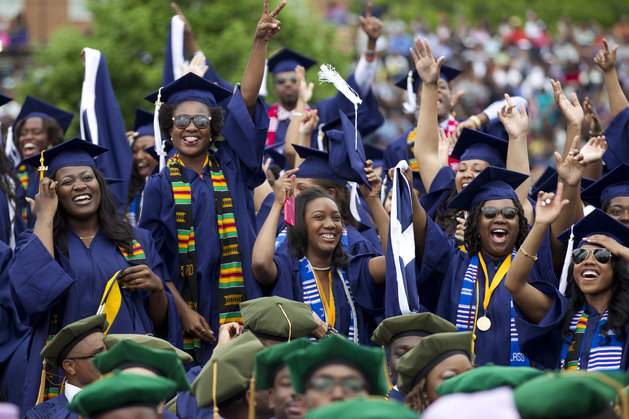
A few minutes into a breakout session at last week’s Creating Change LGBT equality conference in Baltimore, the presenter noted that more than 150 colleges in the U.S. have programs aimed at supporting LGBT students—but none of those schools are HBCUs.
Historically black colleges and universities, presenter Dominique McIntosh said, “are lagging behind in providing institutional support.” While HBCUs have long been known for providing greater support for their students than majority-serving institutions, based on her research, she sees a different story emerging for students who fit outside of the dominant narrative of “black womanhood.”
Recently, McIntosh, a professor at Smith College, conducted a focus group at a southern HBCU—she declined to say which to protect the anonymity of her subjects—and there she found that traditional themes of black womanhood like “resisting domination, respectability, and relationship to men,” are being challenged by black lesbians and bisexual women, who, in addition to respectability, find “resisting stereotypes, and relationships to women” more important. These women also said traditional ideas of the positivity of sisterhood and “othermothers”—concerned female caretakers in the community—can be estranging and sometimes intrusive.
McIntosh’s findings were fascinating, but of the 2200 registered attendees at the National Gay and Lesbian Task Force’s annual conference, only about 10 sat in on her presentation.
A few doors down, dozens of young people attended a session on how to build a youth-led organization—of which there are only a few in the country. The presenter drew parallels between the National Women’s Party (NWP) and the Student Nonviolent Coordinating Committee (SNCC), two successful youth-led organizations that found themselves frequently at odds with their more grown-up counterparts within the suffrage and civl rights movements.
Only a handful of youth-led LGBT organizations exist today. “We’re a very small tribe,” said Jason Landau Goodman of the Pennsylvania Student Equality Coalition. Most often, he added, larger, established LGBT advocacy groups bring in a youth voice as a token, or to represent the problems with mental health and bullying. Rarely is the resilience or proactivity of young people shown.
Audience members agreed. “Youth are portrayed as victims,” one attendee said. Another added, “By the time you’re no longer a youth, is when you’ll have a say.”
The session offered tips for creating a youth organization: fighting burnout and adultism, and recognizing privilege are key, said Goodman.
Perhaps a sign that young LGBT activists are hungry for help organizing, the conference attendees seemed to skew younger—though there were plenty of middle aged and older attendees—and they represented a wide range of racial diversity and gender identity. “Usually LGBT conferences aren’t diverse at all,” said Felipe Matos, a DREAM Act and LGBT activist.
And the sessions were pegged toward just about every intersection of LGBTQ identity. Of the 140 or so breakout sessions, caucuses, and open meetings on Saturday, 22 were explicitly about race. There were sessions about the black church, sex positivity and people of color, the history of Native Americans honoring “multiple gender traditions,” how immigrant and LGBTQ communities can work together, and ways of reducing violence agains transgender and gender-nonconforming people of color.
The Saturday plenary session was devoted to international LGBT activism. Last week marked the one-year anniversary of the death of David Kato, a Ugandan teacher and LGBT activist who was murdered in his home after winning a lawsuit against a magazine that published his name and address—along with those of others the editors believed to be gay or lesbian.
There are positive things happening in Uganda though, activist Val Kalende told the audience. “Journalists come to Uganda and all they say is people are being arrested.” But she says she’s seen a “new breed of activism” in the wake of Kato’s murder. “Now is the time to ask us what we need on the ground.” While it’s important to monitor things like the so-called “kill the gays” bill going before Uganda’s parliament—it would criminalize homosexuality as an offense punishable by death or life imprisonment—supporting the activism that’s happening in the country is critical.
On the domestic front, the National Black Justice Coalition (NBJC) was handing out statistics on black transgender people pulled from the results of a national survey conducted by the National Gay and Lesbian Task Force and the National Center for Transgender Equality. In the results, half of black transgender people in school reported being harassed, 27 percent reported physical assault, and 15 percent reported sexual assault. Twenty-one percent left school because of harassment. Six percent said they were expelled due to bias.
If one theme emerged from the people I spoke to at the conference, it was that “activating” the power of under-heard groups like people and youth of color is desperately needed. “The youth of color community doesn’t feel like it has a voice,” says Rodney Nickens, Jr., a senior fellow with the NBJC. “No one is hearing their perspective.” For that, he says, Creating Change “has been phenomenal.”
Sarah Audelo, the senior domestic policy manager at Advocates For Youth, an organization that promotes reproductive and sexual health for young people, agrees that young people, “and youth of color especially,” aren’t being heard. “I love that there is something” for youth to attend, but she adds, “I think the conference could be more intentional about how it brings youth of color together.”
One suggestion? “We should have had some workshops to help youth of color organize,” Audelo says. “We just expect them to come into the larger queer movement.”
Article courtesy of Colorlines.com



